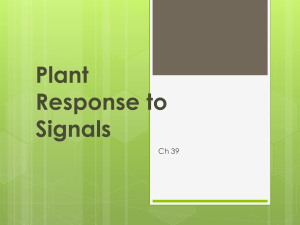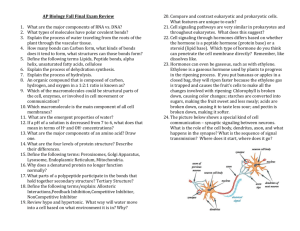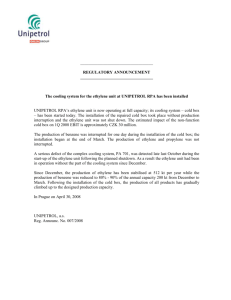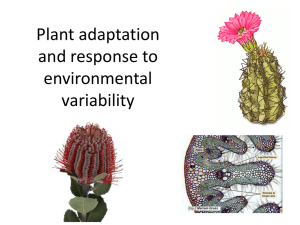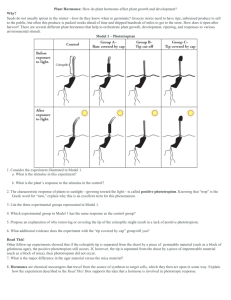Changes in Sugars, Enzymic Activities and Acid or Stored in 2.5%02
advertisement
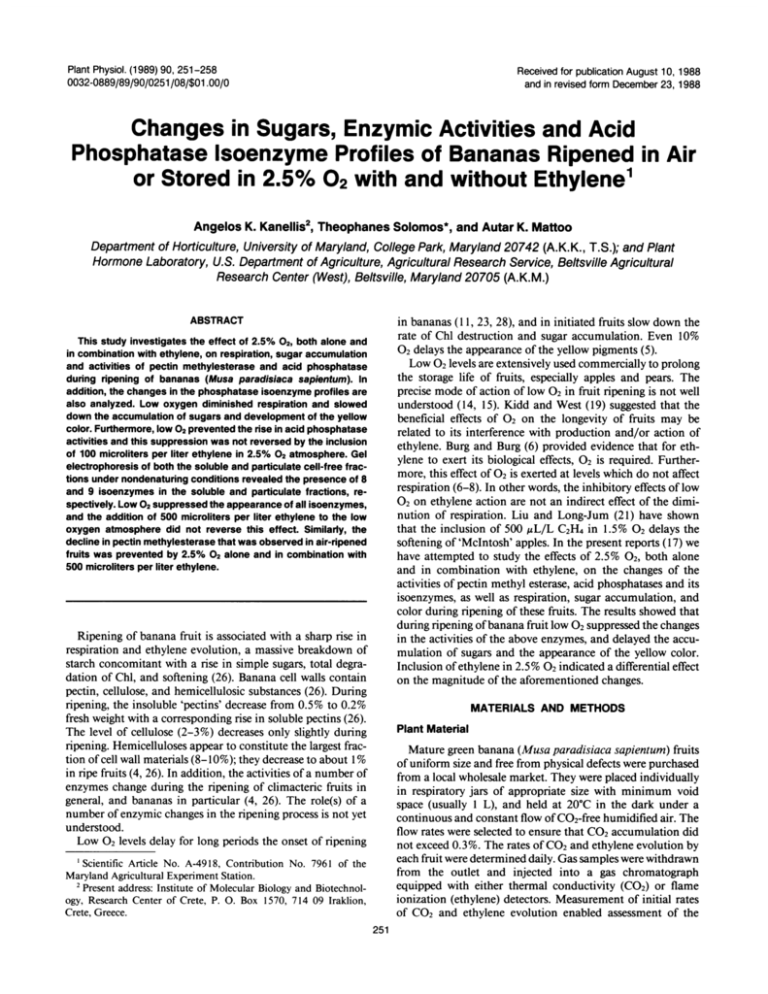
Plant Physiol. (1989) 90, 251-258 0032-0889/89/90/0251 /08/$01 .00/0 Received for publication August 10, 1988 and in revised form December 23, 1988 Changes in Sugars, Enzymic Activities and Acid Phosphatase lsoenzyme Profiles of Bananas Ripened in Air or Stored in 2.5%02 with and without Ethylene1 Angelos K. Kanellis2, Theophanes Solomos*, and Autar K. Mattoo Department of Horticulture, University of Maryland, College Park, Maryland 20742 (A.K.K., T.S.); and Plant Hormone Laboratory, U.S. Department of Agriculture, Agricultural Research Service, Beltsville Agricultural Research Center (West), Beltsville, Maryland 20705 (A.K.M.) ABSTRACT in bananas (1 1, 23, 28), and in initiated fruits slow down the rate of Chl destruction and sugar accumulation. Even 10% 02 delays the appearance of the yellow pigments (5). Low 02 levels are extensively used commercially to prolong the storage life of fruits, especially apples and pears. The precise mode of action of low 02 in fruit ripening is not well understood (14, 15). Kidd and West (19) suggested that the beneficial effects of 02 on the longevity of fruits may be related to its interference with production and/or action of ethylene. Burg and Burg (6) provided evidence that for ethylene to exert its biological effects, 02 is required. Furthermore, this effect of 02 is exerted at levels which do not affect respiration (6-8). In other words, the inhibitory effects of low 02 on ethylene action are not an indirect effect of the diminution of respiration. Liu and Long-Jum (21) have shown that the inclusion of 500 jtL/L C2H4 in 1.5% 02 delays the softening of 'McIntosh' apples. In the present reports ( 17) we have attempted to study the effects of 2.5% 02, both alone and in combination with ethylene, on the changes of the activities of pectin methyl esterase, acid phosphatases and its isoenzymes, as well as respiration, sugar accumulation, and color during ripening of these fruits. The results showed that during ripening ofbanana fruit low 02 suppressed the changes in the activities of the above enzymes, and delayed the accumulation of sugars and the appearance of the yellow color. Inclusion of ethylene in 2.5% 02 indicated a differential effect on the magnitude of the aforementioned changes. This study investigates the effect of 2.5% 02, both alone and in combination with ethylene, on respiration, sugar accumulation and activities of pectin methylesterase and acid phosphatase during ripening of bananas (Musa paradisiaca sapientum). In addition, the changes in the phosphatase isoenzyme profiles are also analyzed. Low oxygen diminished respiration and slowed down the accumulation of sugars and development of the yellow color. Furthermore, low 02 prevented the rise in acid phosphatase activities and this suppression was not reversed by the inclusion of 100 microliters per liter ethylene in 2.5% 02 atmosphere. Gel electrophoresis of both the soluble and particulate cell-free fractions under nondenaturing conditions revealed the presence of 8 and 9 isoenzymes in the soluble and particulate fractions, respectively. Low 02 suppressed the appearance of all isoenzymes, and the addition of 500 microliters per liter ethylene to the low oxygen atmosphere did not reverse this effect. Similarly, the decline in pectin methylesterase that was observed in air-ripened fruits was prevented by 2.5% 02 alone and in combination with 500 microliters per liter ethylene. Ripening of banana fruit is associated with a sharp rise in respiration and ethylene evolution, a massive breakdown of starch concomitant with a rise in simple sugars, total degradation of Chl, and softening (26). Banana cell walls contain pectin, cellulose, and hemicellulosic substances (26). During ripening, the insoluble 'pectins' decrease from 0.5% to 0.2% fresh weight with a corresponding rise in soluble pectins (26). The level of cellulose (2-3%) decreases only slightly during ripening. Hemicelluloses appear to constitute the largest fraction of cell wall materials (8-10%); they decrease to about 1 % in ripe fruits (4, 26). In addition, the activities of a number of enzymes change during the ripening of climacteric fruits in general, and bananas in particular (4, 26). The role(s) of a number of enzymic changes in the ripening process is not yet understood. Low 02 levels delay for long periods the onset of ripening MATERIALS AND METHODS Plant Material Mature green banana (Musa paradisiaca sapientum) fruits of uniform size and free from physical defects were purchased from a local wholesale market. They were placed individually in respiratory jars of appropriate size with minimum void space (usually 1 L), and held at 20°C in the dark under a continuous and constant flow of C02-free humidified air. The flow rates were selected to ensure that CO2 accumulation did not exceed 0.3%. The rates of CO2 and ethylene evolution by each fruit were determined daily. Gas samples were withdrawn from the outlet and injected into a gas chromatograph equipped with either thermal conductivity (CO2) or flame ionization (ethylene) detectors. Measurement of initial rates of CO2 and ethylene evolution enabled assessment of the ' Scientific Article No. A-4918, Contribution No. 7961 of the Maryland Agricultural Experiment Station. Present address: Institute of Molecular Biology and Biotechnology, Research Center of Crete, P. 0. Box 1570, 714 09 Iraklion, Crete, Greece. 2 251 252 KANELLIS ET AL. physiological stage of the fruits. Only those green fruits that hardly evolved ethylene were used for the experiments. These preclimacteric fruits were treated with ethylene by passing over them a continuous stream of C02-free air containing 5 to 10 ,L/L ethylene. When the respiration rates reached 30 to 40 mL CO2.Kg-'.h-', i.e. one-third to one-half of their climacteric peak value, the exogenous supply of ethylene was discontinued. The fruits were then separated into three batches, each containing an equal number of fruits (usually 3). One batch was kept in air, the second was subjected to 2.5% 02, while the third was treated with a mixture of 2.5% 02 and either 18 ML/L ethylene (experiment 1) or 500 ,OL/L ethylene (experiment 2). The fruits were kept under the respective gaseous environment for 6 d, and then transferred to air. Sampling Method To diminish the variations between different fruits, samples of mesocarp tissue were withdrawn from a single fruit by the method of Awad and Young (1). The method involves removal of cylindrical plugs (2-3 g) with a stainless steel cork borer 10 mm in diameter. One plug of tissue was withdrawn from each fruit at the preclimacteric stage, at the time of transfer to low 02 atmosphere, or low 02 and ethylene atmosphere, and every 48 h (experiment 2) or 72 h (experiment 1) thereafter up to 6 d, and after 2 d upon return of the fruits to air. After removal of the pulp tissue, the resulting holes in the fruit were immediately sealed with lanolin and the fruits were returned at once to the respiratory jars. Pulp tissue plugs were ground in liquid N2 with mortar and pestle and the fine powder stored at -70C until used. In preliminary experiments, the effect of wounding on CO2 and ethylene evolution due to the removal of tissue plugs from fruits was evaluated. Awad and Young (1) observed that wounding did not alter the rate of either respiration or ethylene evolution. In preliminary experiments, we verified these observations. In addition, the PME3 and AP activities in intact fruits, and in those from which plugs of tissue had been removed, were similar in both cases. Color For color change determinations (green to yellow) a different sampling procedure was followed. Green preclimacteric fruits were enclosed in respiratory jars and three fruits from the air control and three from 2.5% 02 atmosphere were removed after 0, 2, 4, 7, 10, and 13 d following the transfer to low 02. Hunter L, a, b, values were determined using the Pacific Scientific Spectrogard Color System4 (10). Measurements of L, a, b, were taken on six different surface portions of each fruit and the average was used for calculations. The instrument was calibrated with white and black standards. The data are expressed as La/b, which is a measure of the rate of change from green to yellow. 3 Abbreviations: PME, pectinmethylesterase; AP, acid phosphatase; PVPP, polyvinylpolypyrrolidone. 4 Mention of specific instruments, trade names, or manufacturers is for the purpose ofidentification and does not imply an endorsement by the U.S. Government. Plant Physiol. Vol. 90, 1989 Sugars One g of frozen fine mesocarp powder was boiled in 70% ethanol for 15 min and left overnight at room temperature. The following day, the mixture was centrifuged at 21,000g for 15 min. The supernatant was filtered through 0.45 gm HA Millipore membrane and 25 tiL were analyzed by HPLC using a carbohydrate column (Waters Associates). The sugars were eluted from the column with 85% (v/v) acetonitrilewater at a flow rate of 2.0 mL/min. A refractive index detector (Waters Associates) was used for the quantification of sugars. The data are expressed as u mol g-' (fresh weight). Extraction and Assay of Pectinmethylesterase One g of frozen ground pulp was thawed in 4 mL of icecold isolation medium containing 0.1 M Na-acetate (pH 5), 0.5 M NaCl, 2% PVP, 5 mm DTT, 5 mM j3-mercaptoethanol, 0.5 mM PMSF, 1 mm diethyldithiocarbamic acid, and 0.5% (v/v) Triton X-100. Alternatively, the frozen tissue was thawed in 4 mL of0.5 M Na-acetate (pH 7.5), 1% polyethylene glycol, 5 mm DTT, 5 mm fl-mercaptoethanol, 0.5 mm PMSF, and 1 mM diethyldithiocarbamic acid. After being thawed, the mixture was vortexed eight times for 5 s, with a 2-min interval between vortexing during which it was cooled on ice. The homogenate was centrifuged at 20,000g for 20 min and the supernatant saved for enzyme assays. PME was assayed by the method of Rouse and Atkins (31) with slight modifications. Of the supernatant, 1.5 mL were added to 10 mL of 0.5% (w/v) solution of pectin (Sigma) in 0.1 M NaCl. The mixture was brought rapidly to pH 7.5 with dilute NaOH. The release of carboxyl groups was monitored at 25°C for 10 min with an automatic titrator (Methrom Herisau) using 0.01 N NaOH. PME units are expressed in ,umol of ester hydrolyzed .g-' . min-'. Extraction and Assay of Acid Phosphatase Preliminary experiments showed that the buffer used for the extraction of pectinmethylesterase proved to be very satisfactory for the isolation of total AP. The activity of AP in the cleared homogenate was measured in a reaction mixture containing 40 ,uL of 30 mg ml-' of p-nitrophenyl phosphate in 0.1 M Na-acetate (pH 5), in a final volume of 5 mL. Fifty gL of the extract were added to initiate the enzyme reaction. The tubes were incubated in a shaking water bath maintained at 40°C (9). One-mL aliquots of the reaction mixture were removed at intervals, added to 3 mL of 0.02 N NaOH and shaken. The absorbance at 407 nm was measured after 15 min. AP units are expressed in ,tmol of p-nitrophenyl phosphate hydrolyzed.g-' . h'. The enzyme assays were based on measurements of the zero order rate. Extraction and PAGE of Acid Phosphatase Isoenzymes One g of frozen pulverized pulp tissue was mixed with 1.5 mL of 50 mm Tris-HCl (pH 7.5), containing 5 mM f3-mercaptoethanol, 0.5 mm PMSF, 10 jtM, leupeptin, 1 mm diethyldithiocarbamic acid, 5% (w/w, fresh weight) PVPP, 1 mM EDTA, and 10% (v/v) glycerol. After thawing on ice, AP was EFFECT OF LOW 02 ON BANANA CELL WALL ENZYMES solubilized by vortexing the mixture three times for 5 s with interval of 5 min while the mixture was left on ice, then centrifuged at 21,000g for 60 min. The supernatant was saved for enzyme assays. The pellet was resuspended in 1 mL of 50 mM Tris-HCI (pH 7.5), containing 10 mM f3-mercaptoethanol, 0.5 mM PMSF, 10 ,uM leupeptin, 1 mM diethyldithiocarbamic acid, 1 mM EDTA, 10% (v/v) glycerol, 0.5 M NaCl, and 0.5% (v/v) Triton X- 100 and left on ice for 15 min with intermittent vortexing as mentioned above. The mixture was centrifuged at 21,000g for 60 min, and the supernatant served as a source of particulate enzyme. Both soluble and particulate fractions were recentrifuged at 45,000 rpm for 60 min in a Beckman 50 Ti rotor. The clear supernatants were divided into 0.5 mL aliquots and were then stored at -70°C until used. Acid phosphatase isoenzymes were analyzed by a modification (16) of the cathodic system of Reisfeld et al. (29), using 5C0.66T-1 lCO.66 gradient polyacrylamide gels. The stacking gel consisted of 3.75T2.5C polyacrylamide. Electrophoresis was carried out in 0.35 M j3-alanine-0. 14 M acetic acid (pH 4.3), maintained at 2 to 3°C by connecting the cooling coil with a constant temperature (-4°C) bath. The current was set at 30 mA till the samples moved in the stacking gel and then raised to 50 mA. The current was stopped 1.5 h after the tracking dye had run out of the gel. an 253 above was followed except that the initial washings in ABS omitted. were Protein Determination Proteins from each sample were precipitated with ice cold tricholoroacetic acid (10% final concentration) and measured according to Lowry et al. (22). All treatments were run with three replicates and each experiment was repeated at least twice. RESULTS Extraction of Pectinmethylesterase A two-step procedure using high ionic strength buffer at pH 7.5 has been reported to extract all the PME from banana pulp (3). We found that using the extraction buffer at pH 5 resulted in higher PME activity in a one-step procedure compared to a one-step procedure in which high ionic strength buffer at pH 7.5 was used (Table I). Combinations of salt with Triton X-100 and various protease inhibitors seemed to release all of the bound enzyme and this was true with tissue at all stages of ripeness. Color Changes in Response to 2.5% 02 Electrophoretic Blotting Procedure Following electrophoresis, the gel was equilibrated for 60 min by shaking it in prechilled transfer buffer containing 25 mM Tris-192 mm glycine buffer (35) (pH 8.3) with four changes every 15 min. The proteins were then electrophoretically transferred on to nitrocellulose sheets (0.1 ILM pore size, Schleicher and Schuell) in a Bio-Rad transblot cell that had previously been filled with prechilled transfer buffer. The nitrocellulose paper faced the anode and the transfer was completed in 3 h at 80 V. The temperature of the buffer was maintained at 5 to 6 °C by using a cooling apparatus. Activity Staining of Acid Phosphatase isoenzymes The AP isoenzymes were detected on nitrocellulose filters by devising a rapid method (16). In brief, the electrophoretic blots were soaked in 20 mm Na-acetate (pH 5), 0.8% (w/v) NaCl, and 0.02% (w/v) KC1 (ABS) with four changes for 5 min and then were incubated in the staining solution at room temperature (20C) while being shaken. The AP isoenzymes were visualized according to Vallejos (36) with the following modifications: to reduce undesired background, the staining solution (Fast Garnet GBC) was filtered through a Whatman No. 1 filter paper. The amount of substrate (a-naphthyl-acid phosphate) was reduced by 50%. The staining solution (100 mL) consisted of 96 mL of 50 mm Na-acetate (pH 5), 1 mL of 1 M magnesium chloride, 3 mL of 0.5% (w/v) a-naphthylacid phosphate dissolved in 50% (v/v) acetone and 75 mg of Fast Garnet GBC. When dark purple bands were visible, the blots were washed with 15% (v/v) methanol-7% (v/v) acetic acid. The stained nitrocellulose filters could be stored in dH20 for prolonged periods of time without fading. For enzyme staining on the polyacrylamide gels, the procedure described In fruits held under 2.5% 02 atmosphere, the rate of color change from green to yellow slowed down compared to fruits left in air (Fig. 1). Thus, the yellow color of fruits kept for 16 d at low 02 was less intense compared to control samples after 10 d, the differences being significant at 1% levels. Changes in Sugar Levels in Response to Low 02 Treatments Following initiation of ripening induced by a brief exposure to ethylene, the levels of fructose, glucose, and sucrose in- creased rapidly as the rise in respiration progressed in fruits held in air (Fig. 2). The initial rate of sugar accumulation in the fruits subjected to 2.5% 02 alone or in the presence of 500 AL/L ethylene was much slower than the controls. However, the levels of sugars increased appreciably after 4 d of storage and continued to increase further upon transferring the fruits to air (Fig. 2). Table I. Effect of Buffer Composition on Extractability of Banana Pectinmethylesterase at different stages of ripening Buffer A consisted of: 0.1 M Na-acetate (pH 5), 0.5 M NaCI, 2% PVP, 5 mm DTT, 5 mm f3-mercaptoethanol, 0.5 mM PMSF, 1 mM diethyldithiocarbamic acid, and 0.5% (v/v) Triton X-100. Buffer B consisted of 0.5 M Na-acetate (pH 7.5), 1% (w/v) polyethylene glycol, 5 mM DTT, 5 mmfj-mercaptoethanol, 0.5 mm PMSF, and 1 mM diethyidithiocarbamic acid. Banana PME Extractabilitya Buffer Climactenc Preclimactenc Ripe ± ± 7.70 0 5.01 ± 1.12 A 8.32 0.29 6.77 ± 0.07 4.65 ± 0.70 B 7.32 ± 0.23 a Data in units- g1 min-' are means of 3 fruits ± SD. Plant Physiol. Vol. 90, 1989 KANELLIS ET AL. 254 A IR + La b E 120 10 .5% O2C C-. 0 o 60 LLI - 10 . 180 B AIR 0 4 8 12 16 20 'N DAYS AT 20 C Figure 1. Measurements of color changes, from green to yellow in banana fruits ripened in air and in 2.5% 02. Data are the means of three replicates and vertical bars represent the SD. After 4 d differences were significant at 10% level. 2.5% 02t C2 2 420 E Effect of Low 02 on Respiration LiJ Respiration rates of fruit (Figs. 3 and 4) were typical of earlier work (4, 11, 26, 28). Respiration of fruits ripened in air peaked 3 d after ethylene pretreatment. Once the fruits were transferred to 2.5% 02 atmosphere with or without ethylene, the respiration rates dropped (Figs. 3A and 4A). The rate of CO2 production by the fruits held under 2.5% 02 in the presence of 18 ,uL/L ethylene was more or less similar to that of the fruits kept under 2.5% 02 alone (Fig. 3A). In contrast, CO2 evolution was slightly higher in fruits held in an atmosphere of 500 ,uL/L ethylene and 2.5% 02 as compared to those held in either 2.5% 02 or 2.5% 02 + 18 ,L/L ethylene (Figs. 3A and 4A). Subsequent to the transfer of these fruits to air on d 7, the respiration rate increased and then decreased. However, this increase in respiration did not reach the values exhibited by the fruits ripened throughout in air. Effect of Low 02 on Pectinmethylesterase and Acid Phosphatase Activities PME activity declined soon after ethylene pretreatment (Fig. 4B). As the ripening progressed, and the respiratory climacteric reached its maximum value (Fig. 4A), PME activity continued to decrease in fruits kept in air (Fig. 4B). However, this rate of decline in PME activity was slowed down in fruits held in 2.5% 02 or 2.5% 02 plus ethylene. Subsequent to the transfer to air, PME activity declined precipitously in these fruits. In contrast to the trend in PME activity, total AP activity of fruits ripened in air increased considerably (Figs. 3B and 4C). In fruits held in 2.5% 02 atmosphere, this increase in AP activity did not occur (Figs. 3B and 4C). Inclusion of either 18 ,L/L or 500 ,uL/L ethylene in 2.5% 02 atmosphere did not markedly alter the pattern of AP activity seen in fruit held in 2.5% 02 alone. However, upon transfer of fruits to air after 6 d of storage in low 02, the AP activity markedly increased (Figs. 3B and 4C) for both low 02 treatments. 24 Figur 2. c.% 02eso uasi annieenaro ohngeoff 2the held in 2.5% 02 or2.5% 0 LLehln.Snl riswr 02 sapeion d 02pelmcec,d1(ratdwt tyee,ado 4 6 8 DAYS AT 2000 2. Changes in the levels of sugars in banana ripened in air or Figure Chanesnth in 2.5%02hor Pofilf d /L ethylene. Single fruits were held c fcdPophtsionye 500 2.5%02+ sampled on d 0 (preclimacteric), d 1 (treated with ethylene), and on d 3, 5, and 7. Fruits held in modified atmospheres were returned to air on d 7 (arrows) and sampled on d 9. Data represent the means of three replicate determinations and vertical bars are the SD. 0 2 Changes in the Profile of Acid Phosphatase isoenzymes It has been previously reported that the activity of soluble and particulate AP increases by 2- to 4-fold and 26-fold, respectively, in the course of banana fruit ripening (9). The same authors also concluded that the particulate enzyme activity is mainly desorbed from the cell wall. When soluble and particulate fractions of samples extracted from ripe fruit were run on polyacrylamide gels under nondenaturing conditions, the AP activity was resolved into 8 and 9 bands, respectively (Fig. 5). The faster migrating band (No. 9) of the particulate fraction was not detected in the soluble fraction, suggesting its unique association with the particulate fraction. The changes in AP isoenzymes during ripening of bananas are shown in Figures 6 and 7. No AP isoenzyme was detectable in either the soluble or particulate fraction of green fruits when equal amounts of protein were loaded on the gels (Figs. 6 and 7, day zero). However, AP isoenzymes in the particulate fraction increased first as the fruits ripened (Fig. 7), while EFFECT OF LOW 02 ON BANANA CELL WALL ENZYMES 255 A 60 A C2 H4 40 ;60 IR f of ~~~~~2.5% 02+CX ont4 0- 7 -0 off on .5%0 C H 40 1-1 0% .ir 20 c'J C2H4~~~~~~~~~~~~~~~~~~~~~~~~~~~~~~~~~~~~~~~~~~~~~~~~~~~~~~~~~~~~~ 0 4 18 E -gon B C21-4 .- 7 12 c m .C 6 ~ ~ A2.5% R4 °2H 02 6 2 C 0 2 4 6 DAYS AT 20 0C 8 AIR 10 2- Figure 3. Effect of 2.5% 02 or 2.5% 02 + 18 ,AL/L ethylene on respiration rates (A) and phosphatase activity (B) of banana fruits. The sampling periods were similar to those given in the legend to Figure 2. Figure 4.Efecof2.5°2wito upon transfer of fruits held either in 2.5% 02 or 2.5% 02 + 500 gL/L ethylene to air, the AP isoenzymes were fully expressed (Figs. 6 and 7, lanes 9), suggesting that the fruits resumed features characteristic of normal ripening. DISCUSSION Ripening of bananas is associated with an extensive breakdown of starch, the main carbohydrate reserve comprising 80 to 95% of the dry matter in the green fruit and 5 to 15% in the ripe fruit (24-26), with a corresponding increase in the levels of soluble sugars, mainly sucrose, glucose, and fructose. Accumulation of sucrose occurred earlier than glucose and fructose. Furthermore, the ratio of the increments of glucose over fructose was close to unity, indicating that the immediate precursor of these sugars is sucrose (37). Ripening of banana 2 ~ ~ 6-C2H4 4 ~ ~ those in the soluble fraction appeared later (Fig. 6). Some of the particulate AP isoenzymes (band Nos. 8 and 9) also appeared late in ripening, suggesting developmental differentiation in the expression of AP isoenzymes (Fig. 7). The isoenzyme composition of AP extracted from fruit subjected to 2.5% 02 atmosphere showed three interesting features (Figs. 6 and 7). First, no AP isoenzymes were found to be present in the soluble fraction except on the 7th d of storage. The inclusion of 500 ,uL/L ethylene did not alter this low 02 effect (Figs. 6 and 7). Second, the particulate isoenzymes tended to stain more weakly in low 02-treated fruits compared to air-ripened fruits. The same was true when ethylene was introduced in the 2.5% 02 atmosphere. Third, AP band No. 9 was selectively absent in fruits held in 2.5% 02 and 2.5% 02 + 500 gL/L ethylene atmospheres. However, t2.5%0 those ~ ~ described in the legend to Figure 2. fruits was slower in 2.5% 02 or 2.5% 02 + 500 ML/L ethylene than in air and this was also reflected in the accumulation of the sugars (Fig. 2). During the first 4 d in either 2.5% 02 or 2.5% plus 500 gL/L C2H4, the levels of sugars showed hardly any changes. Thereafter, they began to accumulate but within 9 d failed to reach the levels of the air-ripened fruits (Fig. 2). It is interesting to note that this increase in sugars was reflected in a gradual rise in C02 evolution (Fig. 3). It is also noteworthy that the observed rise in sugar levels and C02 output was not reflected in either total AP activity or appearance of isoenzymes (Figs. 3, 4, 6, 7), suggesting that these events may not be related either temporally or biochemically. PME activity in relation to ripening of various fruits has been reported to increase, decrease, or to remain constant (12, 27). In bananas, the information is conflicting. Hultin and Levine (13) reported a very large increase in PME activity during ripening of bananas. Palmer (26) and Brady (3), on the other hand, took precautions to avoid loss of protein due to high content of phenolics in green fruits and found that the activity of PME remains constant in the course of banana ripening. In our experiments, a constant decline in PME activity was observed in fruits ripened in humidified air. The KANELLIS ET AL. 256 Plant Physiol. Vol. 90, 1989 An'-1 I I 2 3^-- l \ t.11 -4 %:Z,- C AB Figure 5. Comparison of banana acid phosphatase isoenzymes from soluble (A) and particulate fractions (B, C) of climacteric fruits. Numbers represent different acid phosphatase isoenzymes. Acid phosphatase isoenzymes were stained before (A, B) or after (C) electrotransfer of polyacrylamide gel onto nitrocellulose filter with 25 mM Tris-1 92 mm glycine buffer. . 4 / S. 6 ., 4 8 4 Figure 6. Profiles of soluble acid phosphatase isoenzymes from fruit held in either air, 2.5% 02 or 2.5% 02 + 500 ML/L ethylene. Soluble fruit fractions (equivalent to 8 igg protein) were electrophoresed in 5TO.66C-1 1 TO.66C gradient polyacrylamide gel and then electrotransferred onto nitrocellulose filters. Blots were stained for acid phosphatase activity as described in "Materials and Methods." Soluble (A) and particulate (B) fractions were run alongside the other samples for comparison. Sampling periods were the same as described in the legend to Figure 2. discrepancy between these results and those of Brady (3) could be due to one or all of the following reasons: (a) different banana cultivars tested, (b) different extraction procedures used (one step versus two steps), and (c) ripening and storage conditions. Brady (3) held bananas continuously in ethylene atmosphere. The decrease in PME activity observed in air-ripened fruits Figure 7. Profiles of particulate acid phosphatase isoenzymes from banana fruits ripened in air, and 2.5% 02, both with and without 500 AL/L ethylene. Methods are described in the legend to Figure 6. A, soluble fraction. Samples run in lane B were from fruits held for 4 d in 2.5% 02, but the sample contained 16 jig protein as opposed to 8 ,g protein for other lanes. was arrested by either 2.5% 02 or 2.5% 02 plus 500 gL/L ethylene. On the basis of the present data alone it is not possible to indicate whether the arrest in the decrease of PME activity is due to changes in its rate of either synthesis or degradation. However, the data indicate that low 02 prevents both the rise (AP) as well as the decrease (PME) in the activities of enzymes seen in air-ripened fruits. The effect of low 02 on PME activity was reversible since upon returning the fruits to air the pattern of decline in PME activity was similar to fruits ripened in air. The results concerning the changes in total AP activity and appearance of AP isoenzymes indicate that there may be a sequential induction of isoenzymes during ripening of bananas (Figs. 6 and 7). However, the physiological significance of the increase in AP activity and the induction of its isoenzymes in the course of ripening is not clear. Furthermore, there is little information concerning the mechanisms that regulate the synthesis -and degradation of AP during fruit ripening. De Leo and Sacher (9) and Sacher (33) suggested that the increased AP may be involved in the hydrolysis of mononucleotides, which may limit -the synthesis of RNA necessary for the maintenance of the levels of proteins required to sustain cell integrity. This hypothesis may not be sustainable because in most fruits the levels of ATP increase during the course of ripening (2, 32, 34, 38). Based on the effects of inhibitors of both translation and transcription, De Leo and Sacher (9) concluded that the increase in AP activity was due to the de novo synthesis of the enzyme which was dependent upon the synthesis of RNA. Our results tend to support these findings since (a) no AP activity was detected on the blots of preclimacteric fruit extracts, and (b) AP isoenzymes became visible after ethylene treatment, though EFFECT OF LOW 02 ON BANANA CELL WALL ENZYMES traces of total activity could macteric fruits. be detected in extracts of precli- The transfer of bananas to 2.5% 02 suppressed any further expression of AP isoenzymes as well as the appearance of No. 9 isoenzyme. This suppression of the intensity of the staining of AP isoenzymes was reflected in the diminution of the increase in total AP activity (Figs. 3B, 4C, 6, and 7). From these findings it is evident that the amount of AP protein in extracts of fruits held in low 02 atmosphere was much lower than in the fruits ripened in air, suggesting that low 02 may affect either protein or RNA synthesis, or destabilize preexisting mRNA. It has been pointed out in the introduction that the delaying effect of low 02 on ripening may be related to processes other than respiration. The results presented here on the 10. 11. 12. 13. 14. 15. low 02 effect suggest a close relationship between respiration and sugar accumulation. However, since the respiratory rise during ripening may be considered a facet of ethylene action (34), it may be expected to be affected by the 02 levels. In other words, the diminution of respiration is not due to the restriction of the terminal oxidases but rather to the decrease by low 02 of the action of ethylene. It is known that the afflnity of various processes for ethylene differs (30). In this context, it is interesting that respiration was the only process among those tested which responded with increased rates when higher ethylene concentrations (500 ,L, Fig. 4) were supplemented to low 02 atmosphere, suggesting a higher affinity of this system for ethylene in contrast to processes related to AP induction and accumulation of sugars. Furthermore, while the accumulation of sugars increased gradually after 4 d in low 02, no increase in AP activity was observed throughout the duration of low 02 treatment, suggesting differential effects of low 02 on metabolic processes during fruit ripening. 16. 17. 18. 19. 20. 21. 22. 23. ACKNOWLEDGMENTS We thank Dr. Cindy Tong for skillfully drawing the figures and Steven Altman for his assistance with manuscript preparation. LITERATURE CITED 1. Awad M, Young RE (1979) Postharvest variation in cellulase, polygalacturonase and pectinmethylesterase in avocado (Persea americana Mill. cv Fuerte) fruits in relation to respiration and ethylene production. Plant Physiol 64: 306-308 2. Bennett AB, Smith GM, Nichols BG (1987) Regulation of climacteric respiration in ripening avocado fruit. Plant Physiol 83: 973-976 3. Brady CJ (1976) The pectinesterase of the pulp of the banana fruit. Aust J Plant Physiol 3: 163-172 4. Brady CJ (1986) Fruit ripening. Annu Rev Plant Physiol 38: 155-178 5. Brown DJ (1981) The effects of low 02 atmospheres and ethylene and CO2 production, and 1-aminocyclopropane-l-carboxylic acid concentration in banana fruits. MS thesis, University of Maryland, College Park 6. Burg SP, Burg EA (1967) Molecular requirements for the biological activity of ethylene. Plant Physiol 42: 144-152 7. Burg SP, Burg EA (1969) Interaction of ethylene, oxygen and carbon dioxide in the control of fruit ripening. Qual Plant Mater Veg 19: 185-200 8. Burg SP (1973) Ethylene in plant growth. Proc Natl Acad Sci USA 70: 591-597 9. De Leo P, Sacher JA (1970) Senescence. Association of synthesis 24. 25. 26. 27. 28. 29. 30. 31. 32. 257 of acid phosphatase with banana ripening. Plant Physiol 46: 208-211 Delwich MJ, Baumgardner RA (1983) Ground color measurements of peach. J Am Soc Hortic Sci 108: 1012-1016 Hesselman CW, Frebairn HT (1986) Rate of ripening of initiated bananas as influenced by oxygen and ethylene. J Am Soc Hortic Sci 94: 635-637 Hobson GE (1981) Enzymes and texture changes during ripening. In J Fried, MJC Rhodes, eds, Recent Advances in the Biochemistry of Fruits and Vegetables. Academic Press, London, pp 123-132 Hultin HO, Levine AS (1981) Pectinmethylesterase of the ripening banana. J Food Sci 31: 320-327 Kader AA (1980) Prevention of ripening in fruits by use of controlled atmospheres. Food Technol 34: 51-54 Kader AA (1986) Biochemical and physiological basis for effects of controlled and modified atmospheres on fruits and wegetables. Food Technol 40: 99-104 Kanellis AK (1987) Studies on the suppressive effect of 2.5% oxygen on the rate of ripening, activities of hydrolytic enzymes, and gene expression in ripening fruit. PhD thesis, University of Maryland, College Park Kanellis AK, Solomos T, Matoo AK (1989) Hydrolytic enzyme activities and protein pattern of avocado fruit ripened in air and in low oxygen, with and without ethylene. Plant Physiol 90: 257-264 Kidd F, West C (1934) The influence of the composition of the atmosphere upon the incidence of the climacteric in apples. GB Dept Sci Ind Res Rept Food Invest Board 1933: 51-57 Knee M (1980) Physiological responses of apple fruits to oxygen concentrations. Ann Appl Biol 96: 243-253 Knee M (1982) Fruit softening III. Requirement for oxygen and pH effects. J Exp Bot 3: 1263-1269 Liu FW, Long-Jum C (1986) Responses of daminozide-sprayed McIntosh apples to various concentrations of oxygen and ethylene in simulated CA storage. J Am Soc Hortic Sci 111: 404-408 Lowry OH, Rosebrough NJ, Farr AL, Randall RJ (1951) Protein measurement with the Folin phenol reagent. J Biol Chem 193: 265-275 Mapson LW, Robinson JE (1966) Relation between oxygen tension, biosynthesis of ethylene, respiration and ripening changes in banana fruit. J Food Technol 1: 215-225 Marriott J (1980) Bananas-physiology and biochemistry of storage and ripening for optimum quality. CRC Crit Rev Food Sci Nutri 13: 41-88 Marriott J, Robinson M, Karikari SK (1981) Starch and sugar transformation during the ripening of plantains and bananas. J Sci Food Agric 32: 102 1-1026 Palmer JK (1971) The banana. In AC Hulme, ed, The Biochemistry of Fruits and Their Products. Academic Press, London, pp 65-105 Pressey R (1977) Enzymes involved in fruit softening. In RL Ory, AJ St Angelo, eds, Enzymes in Food and Beverage Processing, ACS Symp Series 47. American Chemical Society, Washington, DC pp 172-191 Quazi MH, Freebairn HT (1970) The influence of ethylene, oxygen and carbon dioxide on the ripening of bananas. Bot Gaz 131: 5-14 Reisfeld RA, Lewis UJ, Williams DE (1961) Disc electrophoresis of basic proteins and peptides on polyacrylamide gels. Nature 195: 281-283 Rhodes MJC (1980) The maturation and ripening of fruits. In KV Thimann, ed, Senescence of Plants. CRC Press, Boca Raton, FL pp 157-205 Rouse AH, Atkins CD (1955) Pectinesterase and pectin in commercial citrus juices as determined by methods used at the citrus experiment stations. Univ F1 Agric Exp Stn Bill 570 Rowan KS, McGlasson WB, Pratt HK (1969) Changes in adenosine phosphate in cantaloupe fruit ripening normally and after treatment with ethylene. J Exp Bot 20: 145-155 258 KANELLIS ET AL. 33. Sacher JA (1973) Senescence and postharvest physiology. Annu Rev Plant Physiol 24: 197-224 34. Solomos T (1983) Respiration and energy metabolism in senescing plant tissues. In M Lieberman, ed, Post-Harvest Physiology and Crop Improvement. Plenum Press, New York, pp 61-98 35. Towbin H, Staehelin T, Gordon J (1979) Electrophoretic transfer of proteins from polyacrylamide gels to nitrocellulose sheets: procedure and some applications. Proc Natl Acad Sci USA 76: 4350-4354 Plant Physiol. Vol. 90, 1989 36. Vallejos CE (1983) Enzyme activity staining. In SD Tanksley, TJ Orton, eds, Isoenzymes in Plant Genetics and Breeding, Part A. Elsevier Science Publishers BV, Amsterdam, pp 469516 37. Yang SF, Ho HK (1958) Biochemical studies on post-ripening of banana. J Chinese Chem Soc 5: 71-85 38. Young RE, Biale JB (1967) Phosphorylation in avocado fruit slices in relation to the respiratory climacteric. Plant Physiol 42: 1359-1362

